Imagine you’re going through an article and out of nowhere, an unknown word pops up. Well, we all have been there.
When it comes to content marketing, new concepts and tools are popping up every month. So it’s easy to get annoyed by the never-ending list of definitions you should know.
With that in mind, here is an exhaustive collection of frequently mentioned content marketing terms in the industry. So let’s begin.
Content marketing terms
This content marketing glossary will come in handy when you’re working on shaping your content plan. Besides, you can check off all the essential elements you need to consider for an effective content marketing initiative.
Above-the-fold
This content marketing term refers to the area that prospects see when they first open a website. This includes everything you can view without scrolling down. The idea is that your above-the-fold content should be engaging enough to compel visitors to explore further.
Case in point: King Arthur Flour’s well-designed website. The above-the-fold section of this site does a great job of promoting its best content and letting users search for what they need. Overall, it’s an intuitive user interface.
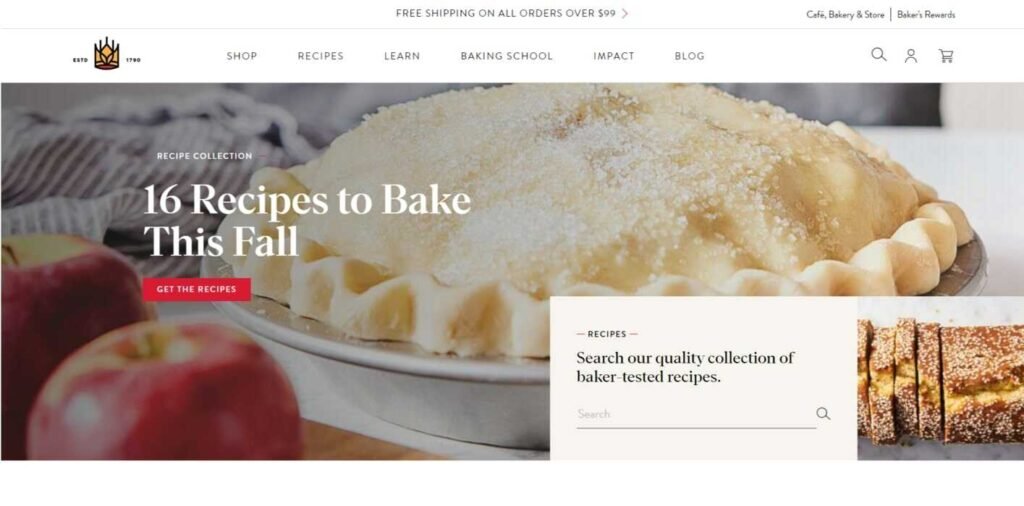
Advertorial
This is a kind of marketing-oriented article that is supposed to fit in naturally with pieces published in a news portal or magazine. Advertorials are different from advertising copy, since they blend in seamlessly with the rest of the content on a website.
Take Metro Parent, for instance. The group provides family and relationship tips and trends on new topics. The piece below is an advertorial created for MetroParent on behalf of Alpine Academy.
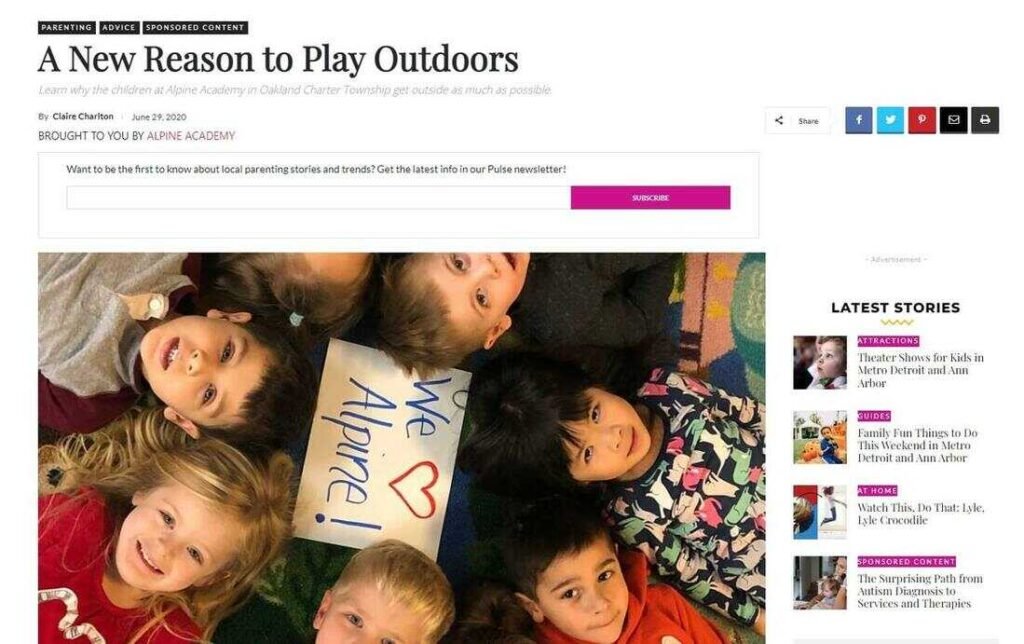
It talks about the benefits of joining the academy. Although it’s promoting the academy, it doesn’t look like an advertisement.
Blog
A blog is a section of a website with content related to your business and valuable to your customers. It may include product updates, reviews, tutorials, and opinions. And it’s regularly updated.
A blog can help you in unlimited ways. It boosts your brand image and trustworthiness as well as gives you a chance to attract visitors and rank higher on search.
Let’s take 9to5Mac, for instance. The blog identifies with Apple buyers and mostly posts updates and opinions on Apple gadgets.
The author started this blog as a side gig to share updates about Macbooks. But now, the blog talks about all Apple devices.
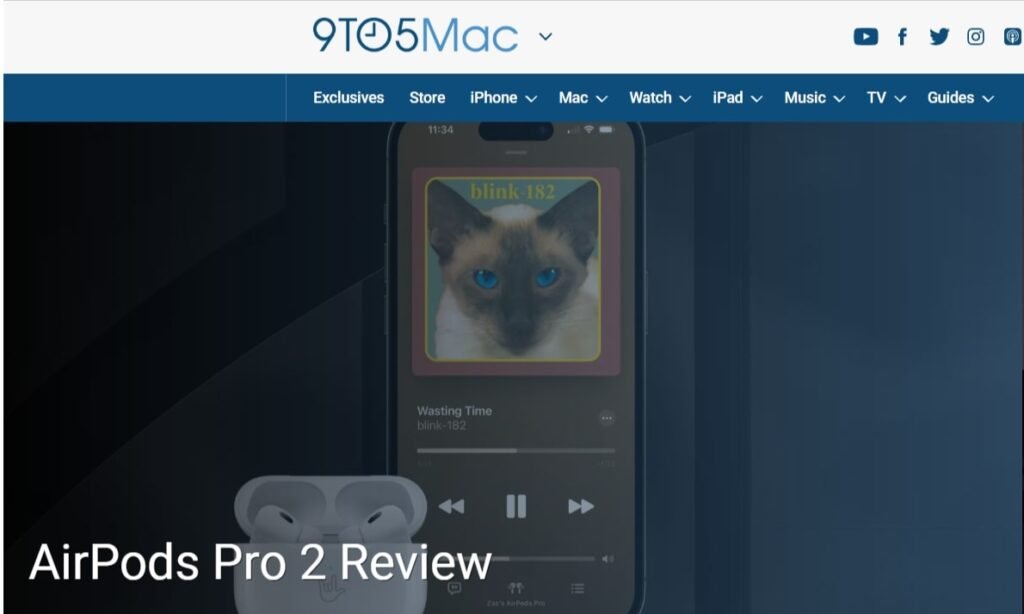
Brand evangelist
Content marketing’s main goal is to engage your target market. If you agree with this, then focusing on building a team of brand evangelists would be among the most desired results of content marketing.
Brand evangelists are passionate about a company and spread the word about it. In simple terms, they become the brand ambassador of the business.
Following are some cases of brand evangelism:
- Thousands of fans standing in a queue waiting for a BTS concert.
- Your colleague telling you the benefits of CrossFit’s premium membership and how it contributes to creating a healthy lifestyle.
- Your young sister expressing her love for a Louis Vuitton bag in front of her girlfriends.
- A group of bike riders in Royal Enfield’s vests riding Royal Enfield two-wheelers on an expressway.
- Your friend who always eats at Subway whenever you meet.
- Your email subscribers forwarding your email to their connections.
Clickbait
Clickbait is a blog post that uses captivating titles and deceptive ways to attract visitors. Usually, blog posts like this take less time and offer little benefit to readers.
It is no longer advisable to keep producing such blog posts because:
- Readers want to read relevant and helpful content
- Marketing mediums are overcrowded and high-quality content stands out
Here are some examples of clickbait titles:
- She dragged her father to the church. His reaction was priceless
- 17 facts about running that will make you quit forever
- He believed he saw a mermaid, until biologists revealed this to him
- 79 yr old fitness coach reveals his anti-aging tips
Content strategy
Next in the list of content marketing terms is content strategy. It is all about mapping, creating, and distributing content that interests, informs, amuses, and motivates your prospects. It aims to help buyers at every stage of the sales cycle.
Let’s look at Stripe’s content strategy as an example. It is a tech firm offering e-payment services to people all over the world.
Not a long time ago, Stripe started a technology-focused publication called Increment. And this was a bold decision for its content marketing plan. The magazine is available for free on the internet. It talks about programming to encourage people in technical roles to join Stripe.
Call to action (CTA)
Call to action or CTA is an essential component of content marketing and deserves to be in any content marketing glossary. It encourages visitors to perform a particular act.
That act can be anything, such as going through your website’s pages, signing up for weekly emails, and promoting your content on social platforms.
Your calls to action could be: get your special offer now, install our free mobile app, book your appointment today, subscribe today, and so on.
Copywriting
Copywriting is all about writing sales messages for different types of promotions.
Copywriters working in the digital marketing field have to create various content pieces. And they need to attract, build credibility, and empathize with the target market in a short time as people have short attention spans.
Case in point: Hiut Denim’s website copy (such as its motto and story) effectively communicates its marketing message and beliefs.
“Do one thing well”
“We make jeans. That’s it. Nothing else.”
“We make the best jeans we can. Not the most jeans we can.”
Copywriting like this establishes Hiut denim’s expertise and sense of ownership over its product.
On top of that, it builds trust among prospects and encourages them to support the company’s endeavors.

Content brief
A content brief is a file that contains the main elements and goals of a particular piece of content. That’s why knowing this content marketing term is necessary.
A clearly written brief helps content writers understand the deadlines, primary quality standards, goals, and context. So that creators can develop effective content.
Below you can see the content brief for avocado fruit benefits.
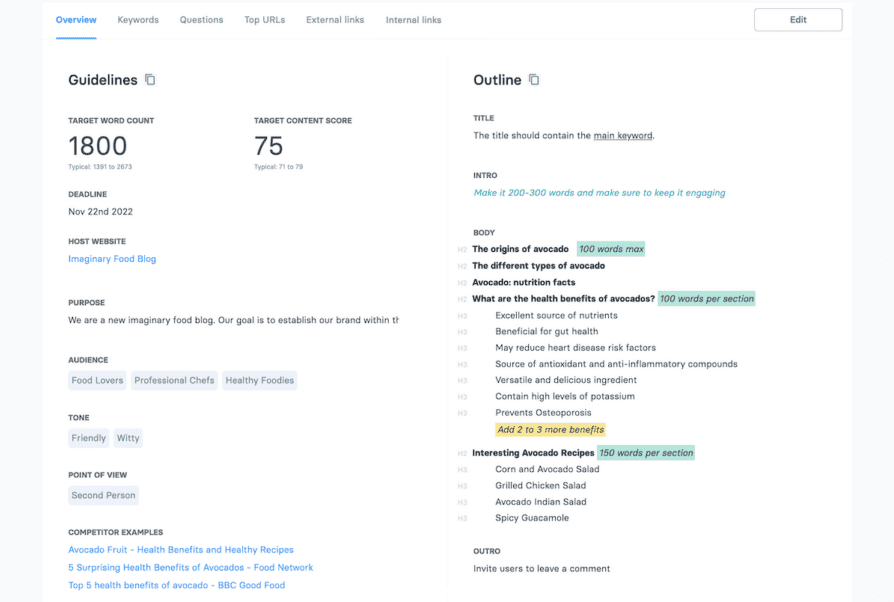
Image source: Zenbrief
Dead link
A dead link is a link in content to a dead page and displays a 404 error. If a web page links to one of your rival’s dead pages, you get the chance to ask the author to replace that link with your latest article.
Take a look at Dribble’s dead page, for example.
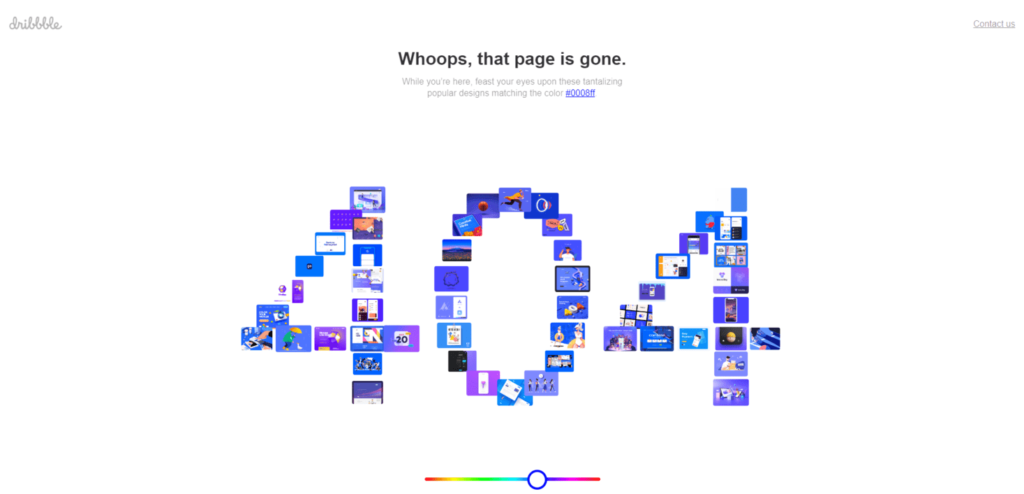
Duplicate content
Duplicate content is content that fully or partially matches the content on another website. If your content is labeled as duplicate, Google will consider it plagiarized and lower its ranking.
Let’s say your website is available at two different addresses, which are www.abc.com and abc.com (one doesn’t have www). There is identical content at both locations. This means you have produced replicas of every page.
This also holds true for websites that keep http:// as well as https://.
If your website is active on all (two) locations and is accessible to Google or any search engine, you might experience a duplicate content problem.
E-books
Ebook is a type of content marketing piece that is comparatively longer than others. This digital handbook is created to upskill your prospects on a specific topic.
It is typically available in digital formats like .epub, .pdf, etc. Ebooks lay the groundwork for bigger plans where you can create several short-form content pieces from longer content.
Case in point: The 5 New IoT Success Metrics, an ebook by Zuora.
Zuora offers premium cloud computing software that helps businesses from all industries to effectively begin, run, and transform into a subscription model.

This ebook establishes trust from the start with the help of B2B stats and illustrations of companies that are transforming the manufacturing sector using IoT.
Evergreen content
It’s a must to include evergreen content in a content marketing glossary. It is a content piece that never loses its worth. Readers find it valuable regardless of when they read it. To sum up, it provides useful data for visitors and does not expire, ever.
For instance, let’s take Smart Passive Income’s comprehensive article on developing and marketing a virtual course written by Pat Flynn.
The writer talks about every angle that allows him to attract searchers from various stages of the cycle. The article is often modified to maintain its usefulness for readers.
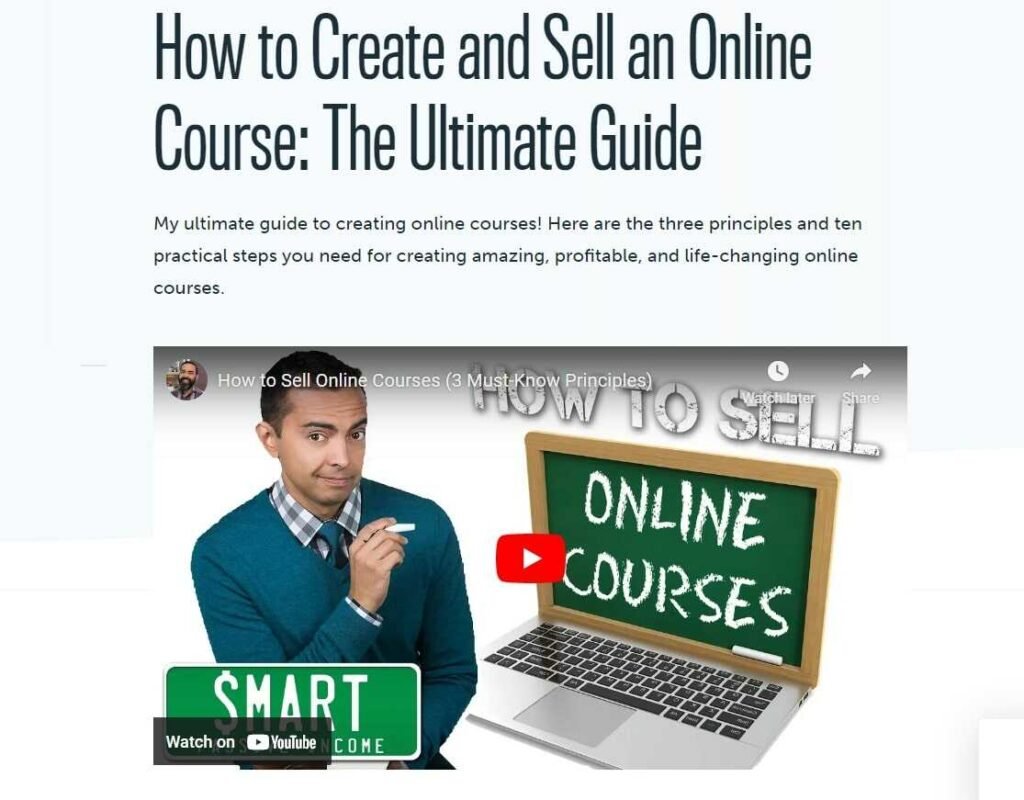
Ephemeral content
There is a prevalent practice on social media sites like Instagram, Facebook, etc wherein the content is available for a limited period. This type of content is called ephemeral content.
Usually, this content has a lifespan of one day and is distributed as videos or pictures.
Instagram stories, online real-time training, and virtual discussions are a few cases of ephemeral content.
Featured snippet
Google started the featured snippet section to improve the relevancy of search results with the help of metadata. This section fetches fundamental data on a subject and shows it in the SERPs (search engine result pages).
Below is an example of a featured snippet for the search term how to start a business.
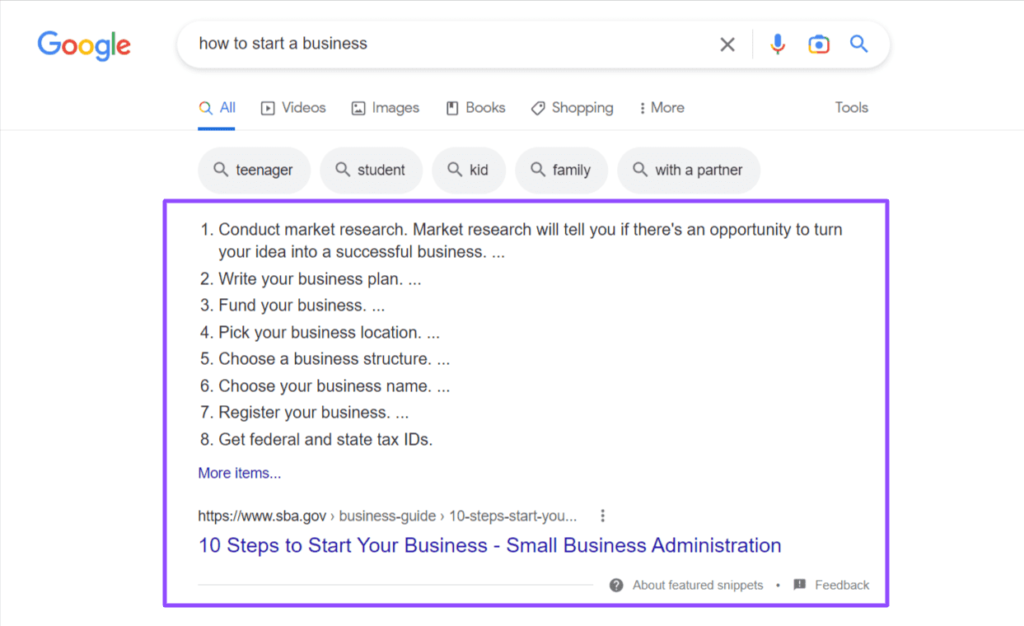
Fresh content
In June 2010, Google came up with a core algorithm update called Caffeine update. This update gave importance to fresh content by including the time of publishing among the ranking factors.
The aim was to favor more recent content that has updated data instead of stale and comprehensive information. After the update, it has become common to update older content pieces.
Take a look at the top-ranking pages for the keyword ‘best headphones’. As you can see, the top three results are those that were published recently.
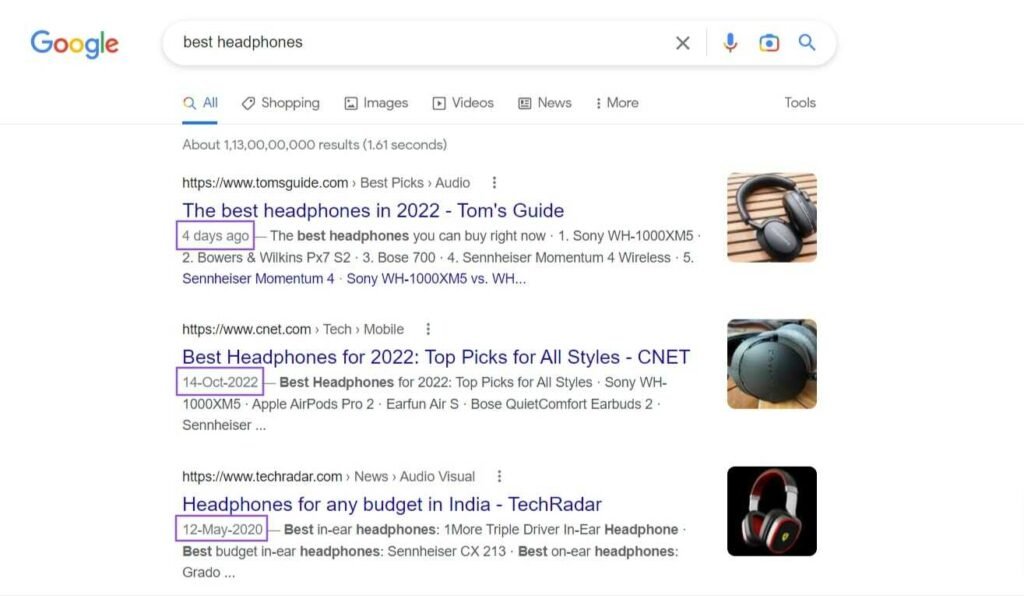
Guest blogging
Guest posting is the process of writing and publishing content on websites that you don’t own.
With the help of this method, you can expand your reach beyond what’s possible through your own website.
Case in point: Adam Enfroy’s guest posting initiative that he began in January 2019. He searched for guest posting possibilities for 15 days. During that time, he reached out to 68 domains. Out of that, he got 28 positive responses. He offered guest posts to 18 websites from those 28.
In the end, his guest posts were published on 8 different websites of those 18. All of these websites had domain authority of more than 60. In short, Adam posted 8 guest posts in 15 days.
By contributing these guest posts, he got 247 total backlinks, out of which 32 were unique backlinks. Not just that, his website started ranking for 268 fresh keywords in Google top 100. The result was a 372% boost in the number of visitors, while his domain rating increased by 12.
There’s more. Adam wrote 80 more guest posts in 2019. As a result, his domain rating shot up from 0 to 76. And the number of visits rose from 0 to 300k per month, which made him $61k every month.

Image source: Adam Enfroy
This story shows that guest blogging is still a viable strategy to increase sales online. The more valuable your backlinks, the better your ranking in search engines.
Ghostwriting
When one person writes content but someone else formally gets recognition for that content, it is called ghostwriting.
Some instances where you can see this are in the making of a screenplay, catchphrase, music, marketing strategy, or promotional projects.
Heading tags
Usually, the heading of a web page is wrapped in a heading tag. The tags are available till H6 starting from H1 and help search engines in locating, classifying, and rating web pages according to the content.
For example, this is how the heading tags look like in a blog post.
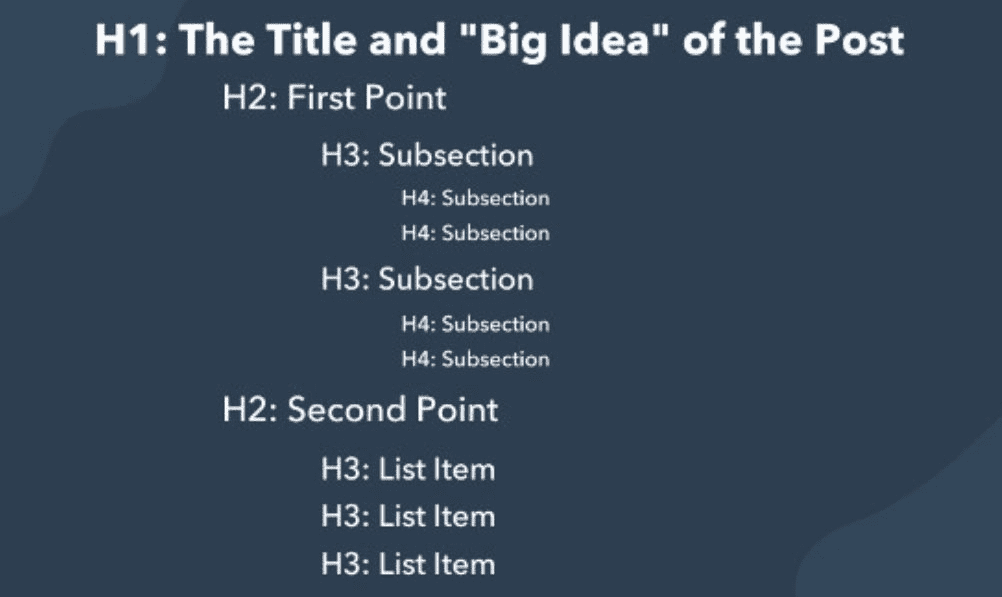
Inbound link
When another website includes a link to your website, the link is called an inbound link. Inbound links from other websites indicate that your content is credible and useful, increasing your SEO performance.
For example, consider the link below pointing to Visme, a presentation design tool.
Visme is an application to design slideshows that improves how you educate and communicate with people in your target market.
The link is wrapped in the phrase “design slideshows.” From our perspective, this is an outbound link. And from Visme’s perspective, it’s inbound.
Infographic
This content marketing term points to an eye-catching piece of content that sums up tricky topics in a simple manner that your prospects can understand. It can use any pertinent data like charts, stats, and so on to get your point across.
For instance, you can check out this infographic by Visual Capitalist that talks about the web’s widely used languages.

Image source: Visual Capitalist
According to the infographic, 60% of sites are available in English. Other languages that made it to the top five are Russian, Spanish, Turkish, and French.
Keyword
Keywords are the terms that your prospects enter into a search engine to find data relevant to them.
It is beneficial to take out the time for keyword research so that you can produce useful content for your target market and improve your web pages.
Let us take an example. Assume that you want to purchase a pair of shoes. So you go to Google and search “men’s white shoes”. This is also a keyword even though it has three words in it.
Keyword stuffing
Deliberately filling your website page with lots of search terms in an effort to trick Google into giving your website a higher rank is called keyword stuffing.
This will probably lead to poor customer experience, low-quality content, and a decline in your search rankings.
Nowadays, search engines do not consider keyword density a primary ranking factor. So, you should create comprehensive and valuable posts.
Let’s say an online retailer who sells kitchen gadgets wants a higher SERP position for the keyword “best coffee maker”.
Here’s what a keyword-stuffed content piece will be like:
“Want to buy the best coffee maker?
You have arrived at the correct place to buy the best coffee maker.
We have the best coffee maker you can find in the market.
It has a built-in coffee grinder, automatic shut-off, and much more which makes it the best coffee maker for you.
Best coffee maker.”
In this copy, it is very clear that the keyword “best coffee maker” has been used unnecessarily and a lot of times. It is even entirely unrelated to the core subject in some places. The point is nobody will call this piece a great copy.
Listicles
The next term I will talk about in this content marketing glossary is the listicle. It is a type of content that is entirely or partially displayed as a collection of resources.
Listicles are popular in content mediums that focus on grabbing readers’ interest and aim to create a consistent point of contact with them.
For instance, let’s take a look at Venngage’s listicles. It posts many such articles (one of those is shown below) and places itself among other similar tools.

Lead
Lead is a person who is curious about your business and offerings, and might turn into a buyer.
Usually, you can get a potential buyer on your database when he/she engages with an advertisement or call to action and provides you with personal data like contact information, email id, or social media accounts.
Let’s take an example of a searcher who arrived at this page (shown below) after conducting a Google search.
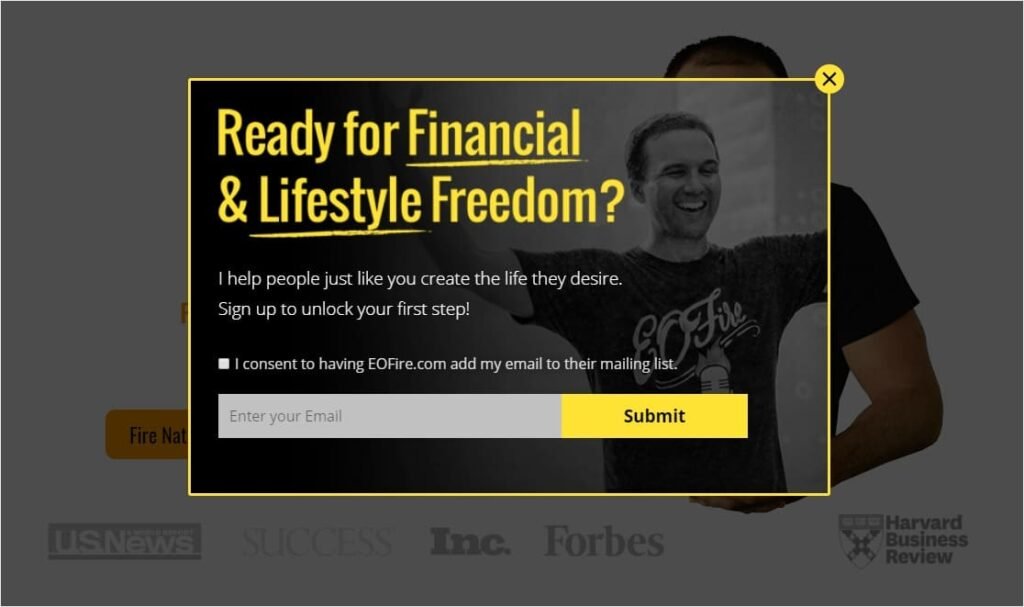
Afterward, if he subscribes to weekly emails, he becomes a lead.
Link building
Link building is an indirect goal of new-age content marketing wherein you create content that shows your expertise in a field. So that others will link to your content, which will be beneficial for your SEO.
Let’s assume for example that you own an e-store that offers healthy snacks, and you want to boost your revenue.
The best approach will be to add your store’s link in a blog or website that talks about healthy lifestyle or food. If possible, you should choose a blog post that covers the ways to switch to healthy snacking options and its benefits.
This way, the reader who is going through that post comes across your website’s link and goes to your website. He might even check your website or better, buy your offerings.
Newsjacking
Newsjacking is the process of making the most of trending news by creating a copy that is strongly connected to the said news story. Creating well-timed and extensive content is the answer to gaining visibility in this space.
Let’s take Calm, a meditation app, for instance. In the year 2020, several companies made an effort to get involved in the United States’ elections. And few brands saw more successful outcomes than others.
Calm, the meditation software, was clearly among the top achievers. This happened mainly because of its advertisements during CNN’s live coverage.

Image source: Semrush
The ads ran for 30 seconds showcasing soothing graphics like raindrops falling on tree leaves. They were strategically positioned as an escape from all the buzz, tension, and jitters of the voting campaigns. The company expertly understood the emotions and feelings of the target market and took action accordingly.
As a result, Calm witnessed a rise in app downloads after the election as well as saw a wonderful ROI.
Promoted post
A promoted post is a type of paid marketing on Facebook and helps you target a larger group of people. It allows you to promote content that is doing great on your newsfeed already. And it appears similar to the ones that are not promoted and may come up in the viewer’s feed.
Let’s take Monday.com, for instance. It is a project management software that works with various operating systems, even Mac.
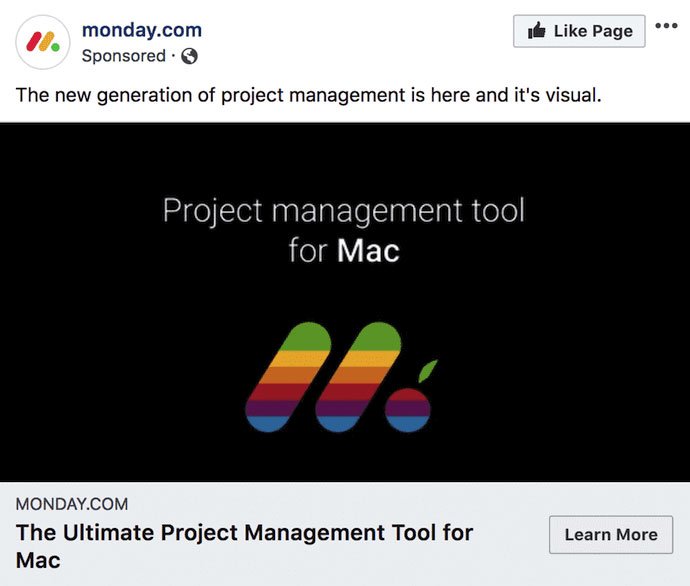
Image source: Cyberclick
In the above post, the brand chose to incorporate the components of its logo with those from Apple. The outcome is neat, elegant, and capitalizes effortlessly on the company’s strength.
RSS
RSS stands for Really Simple Syndication and Rich Site Summary. RSS feeds collect content from many unique sources.
It is a needed technical element for a blog that creates lots of content. External tools can use RSS to crawl and deliver the content produced on the blog.
For example, this is how RSS feeds of CBN look like:
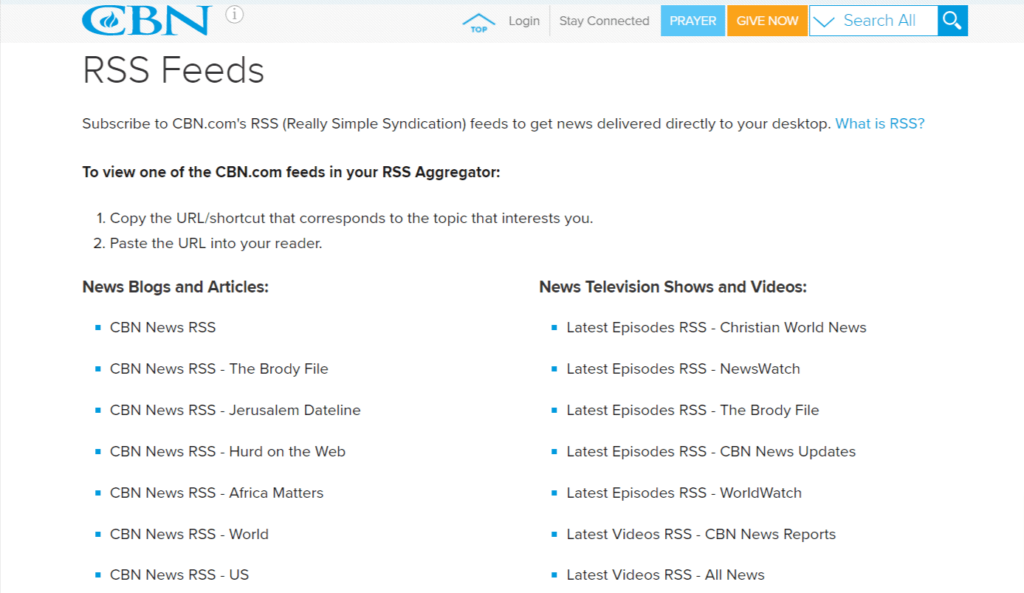
Readability score
Considering the range of templates and content types on the internet, readability has gradually turned into an important consideration while creating content.
Flesch’s readability score is one of the main grading systems which ranks the simplicity of reading from college to 5th standard. It takes into account how long a sentence is on average and the number of syllables in each word.
For instance, grading from zero to 29 denotes that the content is hard to comprehend. And the rating from 90 to 100 implies the text is very easy to understand.
Syndicated content
When third-party blogs post a piece of content that was published somewhere else initially, it is called syndicated content.
Even if your blog post is associated with another website, your name will still be on it. Plus, typically, your website will get a backlink out of this.
Snackable content
Snackable content is short-form content that your audience can easily process while browsing social media. Also, users can distribute this content effortlessly on their social channels.
This type of content targets people with busy schedules or low attention spans to read a comprehensive piece of content.
A few examples of snackable content are useful short videos on LinkedIn, images or videos on Instagram and Twitter, YouTube shorts, and so on.
Thought leadership
Thought leadership content is created to establish you as a trusted source of information in your niche.
Here, the objective is to become a reliable resource for knowledge and upskill the readers with informative articles instead of promoting your goods, solutions, or company. This helps you spread awareness about your company in a subtle way.
For instance, take the sports apparel company REI and its blog. The title of the blog says “expert advice” and the company creates content that covers various subjects about outdoor recreation and lifestyle.
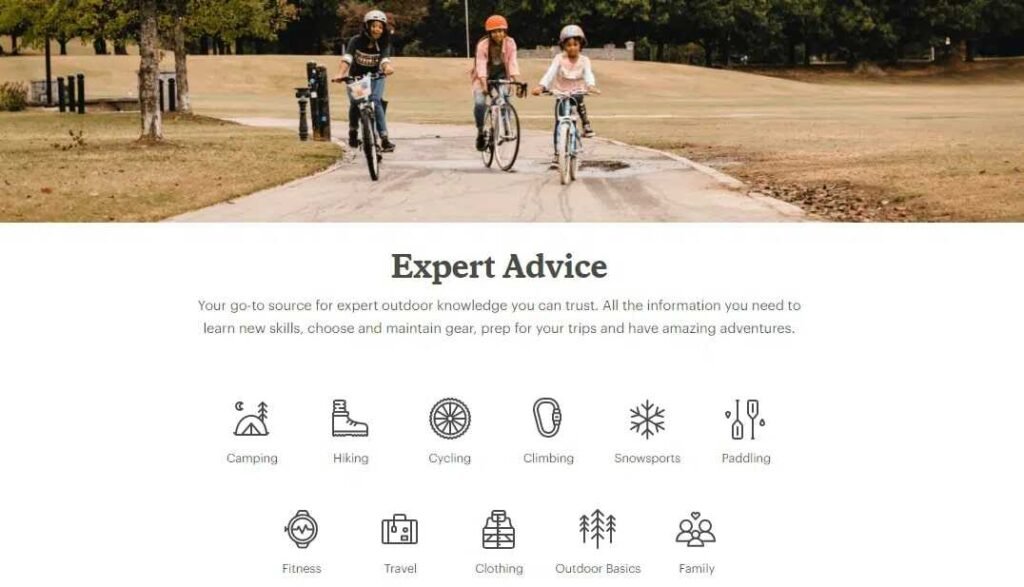
For instance, you can find the type of items you should take on a trekking trip on the blog. And afterward, buy that stuff from REI’s e-store.
This way, the content created by specialists helps the company establish credibility as well as recommend products from its store that meet the demands raised in the blog post.
This approach is a great illustration of the way online stores can build an audience.
Tone of voice
The tone of voice is rarely about things you speak. Instead, it is about the way you speak. It conveys your brand’s character.
To create a distinctive tone of voice, it is crucial to consider your brand’s key values and target market.
Although the buyer might not recall the exact things you say every time, they will never forget the way you affected their emotions.
Let’s take Mailchimp, for example. You see the way Mailchimp’s tone and voice go well with one another. The writing is easy to understand, and the tone seems amicable, pleasant, and welcoming. Mailchimp is there to assist you in expanding your brand, like a reliable mentor.
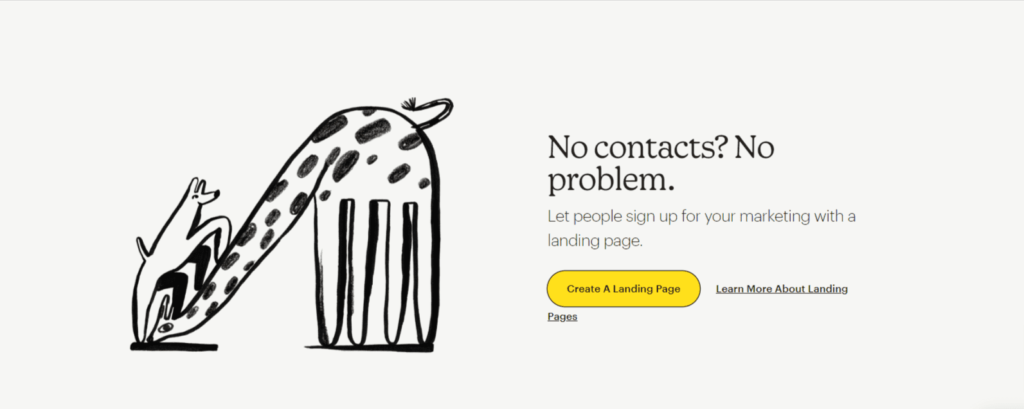
Unique selling proposition (USP)
USP stands for unique selling proposition. What characterizes you?
Although determining your USP and communicating it effectively might need some serious self-examination and imagination, it is among the crucial elements for developing helpful content in a cut-throat industry.
Let’s take WooCommerce’s USP, for example. It goes like this “The most customizable eCommerce platform for building your online business”.

WooCommerce does a good job of centering its USP on a facet of its business that customers find important.
User-generated content
User-generated content is a piece of content that buyers produce, not a company. It could be video blogs, audio clips, written content, pictures, or any other type of content.
The companies notice such content and publish it on their distribution channels like their website and social media.
Case in point: Edloe Finch, a virtual home furnishing retailer. Purchasing such items digitally has some uncertainty attached to it. So, the online retailer added images clicked by customers on its product pages in an attempt to make online shopping simpler.

Vlog
A vlog is basically a blog in video format. It is now among the well-known forms of web content. It can either contain only videos or include complimentary textual content and pictures.
For example, Linus Tech Tips, a YouTube channel managed by Linus. And it is obvious from the name that it talks about technology.
The channel has more than 9 million followers. Unsurprisingly, it widely shares content like entertaining activities, the latest news, review videos, and suggestions.
Whitepaper
A whitepaper is a comprehensive analysis or manual explaining a specific subject and issues related to the issue. It is written with the aim of informing the audience and addressing the problems raised in the paper.
It is a descriptive form of content like an ebook. So, what sets a whitepaper apart from an ebook?
Whitepapers are likely to be on the academic side and include content that is usually supported by in-depth studies and data.
Let’s take Hitachi, for instance. Although it is involved in various sectors of the IT industry, it focuses primarily on providing storage devices to businesses of all sizes.
The company has published a whitepaper called Hitachi Content Platform Architecture Fundamentals. The paper focuses on establishing Hitachi’s content platform as the perfect solution to back current content-based apps, the latest storage instances, and other tasks for large, medium, and small companies.

It talks about the services offered and emphasizes getting the attention of customers who are in the evaluation phase.
Web 2.0
Web 2.0 refers to the second generation of the web, which went past websites and gave birth to social media sites like Reddit, Facebook, Twitter, and Myspace. These sites are filled with compelling UGC (user-generated content). Web 2.0 places a high focus on online groups and knowledge exchange.
YouTube
YouTube is a well-known video-sharing and hosting platform on the internet in current times and has millions of published videos. Google owns this giant video-sharing platform.
YouTube is an excellent content distribution channel because it offers a wide variety of video content such as song videos, vlogs, how-to manuals, and tutorial videos.
The majority of people, particularly the new generation, favor the huge range of content offered by YouTube over regular TV.
Zeitgeist
Zeitgeist means utilizing social trends or joining in on a cultural movement. It includes picking a piece of content recognized by a community and adding your marketing message to it.
When doing so, it is crucial to present yourself as an added voice, instead of diverting or interfering with the original discussion.
Let’s take Liquid-Plumr, for instance. It is a chemical drain cleanser.
The company saw a surge in the number of vloggers doing extremely fascinating and funny activities. So Liquid-Plumr teamed up with a well-known YouTube channel called Vat19 which is famous for creating absurd dare videos. The firm did this to demonstrate a nasty and intriguing drain-cleaning procedure.
The company utilized YouTube’s well-known “Will it” trend, which explores if the tasks that look implausible or unachievable are actually feasible, and created a YouTube series called “Will it clog?”.
Being in line with the concept, the videos showcased a realistic picture of severe blockages and simultaneously create a feeling of comfort after the drain cleaning.
[YouTube video link: https://www.youtube.com/watch?v=XOnaD3DPmeU]
With this, I have covered mostly all of the important content marketing terms out there.
Summing up: content marketing glossary
Now you are familiar with the common content marketing terms.
Understanding these phrases can help you implement content marketing tactics with greater assurance and success.
Although in no way this is an exhaustive content marketing glossary, I hope it’s enough to simplify the terminologies and phrases that are frequently misconceived.
If there are any more content marketing terms that you would want to add to this glossary, tell me about those in the comments section.



